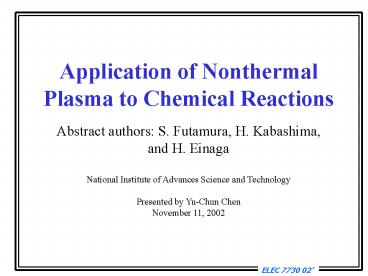ELEC 7730 02 - PowerPoint PPT Presentation
1 / 15
Title:
ELEC 7730 02
Description:
FPR and SDR of conversions of trichloroethylene (TCE) and ... SDR (2) ... FPR and SDR are comparable with each other for the decomposition of halogenated VOCs. ... – PowerPoint PPT presentation
Number of Views:114
Avg rating:3.0/5.0
Title: ELEC 7730 02
1
Application of Nonthermal Plasma to Chemical
Reactions Abstract authors S. Futamura, H.
Kabashima, and H. Einaga National Institute of
Advances Science and Technology Presented by
Yu-Chun Chen November 11, 2002
ELEC 7730 02
2
Introduction
- Applicability of non-thermal plasma (NTP) to
chemical reactions - 1. Removal of hazardous air pollutants
- (HAPs)
- 2. Hydrogen production from small
- molecules
- 3. Hydrocarbon reformimg
ELEC 7730 02'
3
Outline
- From the authors
- NTP
- FPR
- SDR
- Results
- Conclusions
ELEC 7730 02'
4
From The Authors
- Plasma-generating methods greatly affect average
- electron temperature and distribution of
active - species formed in NTP.
- Hybridization of NTP with catalyst/
photocatalyst - is mandatory to increase the energy efficiency
of - the reaction system.
- This paper Comparison of reactor effect between
- FPR and SDR of conversions of
trichloroethylene - (TCE) and CH3Br , and H2 production from H2O
- and CH4 (both in N2)
ELEC 7730 02'
5
NTP
- NTP has been investigated in control of
- 1. Volatile organic compounds (VOCs)
- 2. Nitrogen oxides (NOx)
- 3. Hydrogen production
- 4. Syntheses of methanol, synthesis gas
- Merit
- Gas temperature kept at ambient temperature
in spite of large magnitudes of electron energies
ELEC 7730 02'
6
NTP
- Even without gaseous oxygen, many of VOCs can be
easily decomposed. - Amount of active oxygen species in NTP are not
necessarily large, depending on the
plasma-generating method. - Reason The short lifetime of the high-energy
electron and the partial decomposition of active
oxygen species caused by local temperature inside
NTP.
ELEC 7730 02'
7
FPR (1)(Ferroelectric Packed-bed Reactor)
Ref. S. Futamura, H. Einaga, and A. Zhang,
Behavior of N2 and nitrogen oxides in
non-thermal plasma chemical processing of
hazardous air pollutants , IEEE transactions on
industry applications, Vol. 36, No. 6,
November/December 2000.
ELEC 7730 02'
8
FPR (2)
- Ferroelectric pellet packed-bed reactor
- Operated with a relatively small volume fraction
- of plasma that could catalytically
activated by - free radicals or UV irradiation from the
plasma - Employed an AC power supply in conjunction with a
- ferroelectric pellet layer
- Coaxial reactor
- the inner cylindrical electrode 16.6 mm
- the outer electrode 47.3 mm
- resulting in a gap distance of 15.4 mm
ELEC 7730 02'
9
FPR (3)
- The BaTiO3 pellets (?5000 at room temperature)
- 1. 1mm in diameter
- 2. packed between two electrodes with a
high ac - voltage applied in the radial
direction - 3. held by a notched perforated Teflon
plate at - both ends
- Effective reactor length 127 mm
- The gas passed through the entry tube (6.4mm
- in diameter) and dispersed into the plasma
zone - Gas flow rate 0.25 to 0.5 L/min (nitrogen)
ELEC 7730 02'
10
FPR (4)
- When an external ac voltage was applied across
the high dielectric layer in a radial direction,
the pellets were polarized, and an intense
electric field was formed around each pellet
contact point, resulting in partial discharge. - Maximum applied voltage 50-Hz ac at up to 8-kV
rms.
ELEC 7730 02'
11
SDR (1) (Silent Discharge Plasma Reactor)
AC power supply
Al foil
Cu-coated stainless steel electrode
Gas out
Gas in
Ref. S. Futamura, H. Einaga, and A. Zhang,
Comparsion of reactor performance in the
non-thermal plasma chemical processing of
hazardous air pollutants, IEEE transacitons on
industry applications, Vol. 37, No. 4, August
2001.
ELEC 7730 02'
12
SDR (2)
- Reactor a tubular type consisting of a stainless
steel rod coated with copper (OD 8.6mm?) and an
encircling glass tube (ID 10.6mm ?), which was
wrapped with Al foil (100 mm wide) - The effective reaction length 100 mm
- Gas flow rate 0.1 to 0.25 L/min
- Maximum applied voltage 10 kV
ELEC 7730 02'
13
Result (1)
Reactor effect on the conversions of TCE and
CH3Br in N2
Ref. S. Futamura, H. Kabashima, and H. Einaga,
Application of non-thermal plasma to chemical
reactions , IEEE transactions on industry
applications, 202nd meeting of the
electron-chemical society, Oct. 20-24, 2002.
ELEC 7730 02'
14
Result (2)
Reactor effect on H2 production from H2O and CH4
in N2
Ref. S. Futamura, H. Kabashima, and H. Einaga,
Application of non-thermal plasma to chemical
reactions , IEEE transactions on industry
applications, 202nd meeting of the
electron-chemical society, Oct. 20-24, 2002.
ELEC 7730 02'
15
Conclusion
- From result (1)
- FPR and SDR are comparable with each other
for the decomposition of halogenated VOCs. - From result (2)
- FPR and SDR are quite different for
hydrogen production from water. - Use of a pertinent reactor is important for a
specific purpose.
ELEC 7730 02'































